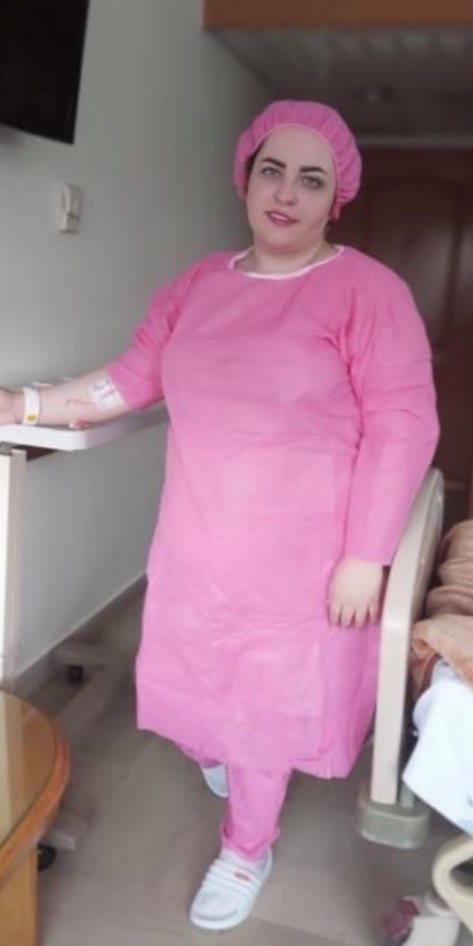Jump To:
Fast Facts
- Approximate Length of Stay: 4-7 Days
- Hospital Stay: 1-2 Days
- Operation Duration: 1.5-2 Hours
- Recovery Period: 2 to 4 Weeks

Gastric Band
The “Gastric Band”, also known as the “Laparoscopic Adjustable Gastric Banding” (LAGB) or simply the “Lap-Band,” is a type of weight-loss surgery (bariatric surgery) that involves placing an adjustable band around the upper part of the stomach. This procedure helps patients lose weight by restricting food intake and creating a feeling of fullness after eating smaller meals. It’s less invasive than other types of bariatric surgeries, as it doesn’t involve altering or removing parts of the stomach or intestines.
How the Gastric Band Works
In the gastric band procedure:
- A surgeon places an inflatable silicone band around the upper portion of the stomach, creating a small pouch above the band and leaving the larger part of the stomach below it.
- The small pouch limits the amount of food that can be consumed at once, helping the patient feel full with less food.
- The band is connected to an access port placed under the skin, allowing the doctor to adjust the tightness of the band by injecting or removing saline through the port. Tightening the band further restricts the stomach, while loosening it can relieve restriction.
The procedure is minimally invasive and is usually done laparoscopically, meaning small incisions are made, and a camera is used to guide the surgery. Most patients can go home the same day or the next day after surgery.
Benefits of the Gastric Band
- Less Invasive and Reversible: Unlike other weight-loss surgeries, the gastric band procedure does not involve cutting or rerouting the stomach or intestines. It’s also reversible; the band can be removed if necessary.
- Adjustable: The band can be adjusted based on the patient’s weight-loss progress, appetite, and comfort, allowing for customized treatment.
- Reduced Risk of Nutritional Deficiencies: Since the digestive tract is not altered, patients are less likely to experience nutrient malabsorption.
- Shorter Hospital Stay and Recovery: The minimally invasive approach allows for a quicker recovery time and a shorter hospital stay compared to other bariatric surgeries.
Risks and Potential Complications
While the gastric band has many advantages, it also has risks and possible complications:
- Band Slippage: Over time, the band can shift from its original position, which may cause pain, nausea, and vomiting. It often requires surgical correction.
- Erosion: In rare cases, the band can gradually erode into the stomach wall, requiring removal.
- Infection at the Port Site: Since the band is connected to a port under the skin, there’s a risk of infection at the port site.
- Slow Weight Loss: Compared to other bariatric surgeries, weight loss with a gastric band is generally slower and may be less dramatic.
- Frequent Adjustments: Some patients require multiple follow-up visits to adjust the band for optimal restriction, which can be inconvenient.
Recovery and Lifestyle Changes
After gastric band surgery, most patients can return to normal activities within 1-2 weeks. However, long-term success depends on significant lifestyle changes:
- Dietary Adjustments: Patients start with a liquid diet, gradually progressing to soft foods and then solids over a few weeks. Eating small, slow, and nutrient-dense meals is essential, as overeating or eating too quickly can cause discomfort.
- Regular Adjustments: Periodic adjustments are needed to ensure that the band provides the right level of restriction. This is done by injecting or removing saline through the port.
- Exercise: Incorporating regular physical activity is crucial for achieving and maintaining weight loss with the gastric band.
- Ongoing Support: Many patients benefit from working with dietitians, counselors, and support groups to help with behavior changes, manage portion sizes, and stay motivated.
Who is a Good Candidate?
The gastric band may be a good option for individuals who:
- Have a BMI of 35-40 with obesity-related health conditions (e.g., type 2 diabetes, high blood pressure) or a BMI of 40 or higher without other health conditions.
- Are committed to making lifelong lifestyle changes, attending follow-up appointments, and adhering to dietary guidelines.
- Prefer a less invasive, reversible weight-loss procedure.
- Are not good candidates for more invasive surgeries due to health concerns.
Long-Term Outcomes
The gastric band can lead to gradual weight loss, typically helping patients lose 30-50% of their excess weight over 3-5 years. However, results can vary based on adherence to lifestyle recommendations. Compared to other bariatric procedures, weight loss with the gastric band tends to be slower, and patients may experience some weight regain if they don’t maintain healthy habits.
The “Gastric Band” can be an effective tool for weight loss, particularly for patients seeking a less invasive and adjustable option. However, its success relies heavily on the patient’s commitment to dietary changes, regular physical activity, and close follow-up care for band adjustments. SHIFA helps you choose the right weight loss method and coordinate with the best weight loss surgeons in Iran.
Compare Before and After Images


Gastric Band
Frequently Asked
Questions
How long will a Gastric Band last?
The lifespan of a Gastric Band can vary, but with proper care and regular follow-up, it can last for many years or even a lifetime. However, adjustments or replacements may be needed over time.
Can Gastric Bands fail?
Yes, Gastric Bands can experience complications or issues that may be considered as “failure.” These can include band slippage, erosion, intolerance, inadequate weight loss, or insufficient restriction. Regular follow-up and proper care can help minimize the risk of complications and optimize the success of the gastric band.
Is Gastric Band Surgery painful?
No, Gastric Band Surgery is not painful because patients are put under general anesthesia and are asleep during the procedure. After surgery, patients are advised to take painkillers regularly for a few days. Shoulder tip pain may also occur due to gas left behind, but this usually goes away within a week.
Why choose SHIFA for Weight Loss Surgery?
SHIFA provides all slimming services and stomach surgeries using expert doctors in well-equipped hospitals in the shortest possible time .We will be with you in all stages of treatment.
SHIFA's Departments
Related Services
Featured Services

Gastric Balloon
The “Gastric Balloon”, or “Intragastric Balloon”, is a non-surgical, temporary weight-loss procedure that involves placing a balloon in the stomach

Rhinoplasty
“Rhinoplasty”, commonly known as a “Nose Job,” is a surgical procedure to alter the shape or function of the nose.<br

Gastric Band
The “Gastric Band”, also known as the “Laparoscopic Adjustable Gastric Banding” (LAGB) or simply the “Lap-Band,” is a type of

Eyebrow Transplant
An “Eyebrow Transplant” is a cosmetic procedure that involves transferring hair follicles, usually from the scalp, to the eyebrow area
Our Blog Articles
- mehdi.mhj@gmail.com
Doccure – Making your clinic painless visit?
Explore the benefits & challenges of virtual healthcare appointments, along with tips for making good...
Read More- mehdi.mhj@gmail.com
5 Great reasons to use an online doctor to choose
Delve into the impact of digital life on mental health & discover practical strategies to...
Read More- mehdi.mhj@gmail.com
Benefits of Consulting With an Online Doctor
Uncover strategies to achieve a harmonious balance between professional and personal well-being....
Read More- mehdi.mhj@gmail.com
What are the benefits of online doctor booking
Explore importance of quality sleep & learn tips to improve your sleep, ensuring raise-up refreshed...
Read More





Comments are closed.